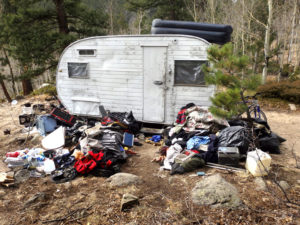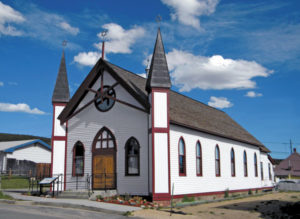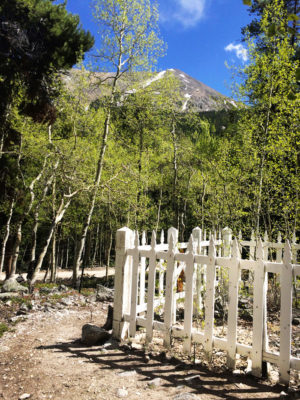By George SIbley
When Ryan Zinke was appointed Secretary of the Department of Interior a year ago, he declared himself to be an “unapologetic admirer of Teddy Roosevelt,” whom we think of as the father of American conservation. Secretary Zinke’s actions since then have caused virtually all contemporary American conservation organizations to call him out on that, and to directly challenge his proclaimed commitment to any concept of conservation.
A look back in history, though, suggests that while he is no conservationist in the conventional contemporary sense of the word, Zinke may be channeling Teddy Roosevelt and his concept of conservation pretty faithfully. This calls attention to the dynamic nature of conservation as an ever-evolving concept in our ever-changing relationship with everything else on the planet.
Roosevelt’s sidekick Gifford Pinchot claimed to have conceived the idea of a broad-based conservation policy in 1907 as a “solitary horseman” out riding meditatively around Washington (sound familiar?). He then worked with Roosevelt and others in the administration to lay out the basic philosophy: “The first great fact about conservation,” he wrote, “is that it stands for development. There has been a fundamental misconception that conservation means nothing but the husbanding of resources for future generations. There could be no more serious mistake. Conservation demands the welfare of this generation first, and afterward the welfare of the generations to follow.”
“In the second place,” Pinchot continued, “conservation stands for the prevention of waste,” pointing often to how nature as well as human industry wasted resources: forest fires burning unchecked, rivers that ran off unused to the ocean in spring floods. “There may be just as much waste in neglecting the development and use of certain natural resources as there is in their destruction.”
Roosevelt took it from there, in 1908 before a thousand governors, congressmen and other leaders he had summoned to the first national conservation conference in Washington. “The wise use of all of our natural resources,” he told the assembled, “is the great material question of today.”
He also focused on waste: the destructive mining of timber and grasslands, the resulting abandonment and erosion, the soil loss from careless or ignorant farming practices, and the wastelands left behind from mineral mining. He echoed Pinchot on nature’s waste of resources.
Wiser, more efficient use of the nation’s remaining resources was the solution. Through better management, he said, “man can improve on nature by compelling its resources to renew and even reconstruct themselves in such manner as to serve increasingly beneficial uses, while the living waters can be so controlled as to multiply their benefits.”
By 1908 he had already launched major elements of his conservation agenda. Here in Central Colorado, his new Bureau of Reclamation was at work on the five-mile tunnel to move Gunnison River water from the Black Canyon to the Uncompahgre Valley. Down in Arizona, the Bureau was building the Theodore Roosevelt Dam for the Salt River Project that enabled the growth of Phoenix. Reclamation was conservation: control the “living waters … to multiply their benefits” before the waters are “wasted” to the ocean.
And Forest Service Ranger Number One, William Kreutzer, was raising hell here among the ranchers and woodcutters in the newly designated Gunnison National Forest (1905), demanding not only that they use the resources of the forest and grasslands more responsibly, but that they start paying for the public resources they’d been using free.
That was but a small piece of 230 million acres of the remaining public lands that Roosevelt put under some form of administrative control. Two-thirds were designated as national forests, and removed from the Department of the Interior’s domain to the Department of Agriculture by Pinchot, a clear signal that these would be “working forests,” producing wood and water for beneficial use; the U.S. Forest Service was created to begin that work, and crews began to fight forest fires that had previously burned wild and wasted the resources.
The other 80 million acres of public land put into reserved status was primarily in national parks, national monuments and wildlife preserves. Roosevelt talked Congress into passing the American Antiquities Preservation Act enabling the president to create national monuments without having to get the Congressional approval needed for national park status. He did nothing, however, to actively preserve these lands; the Park Service was not created until 1916 under President Wilson; Roosevelt’s first priority was to exemplify the efficient development of the nation’s resources.
This was an active, muscular conservation; it moved the national consciousness from thoughtless human use toward use for “the greatest good for the greatest number for the longest time,” but it was still a very use-oriented conservation, whose purpose, he stated, was responsible development that addressed “the problem of national efficiency, the patriotic duty of insuring the safety and continuity of the nation.”
[InContentAdTwo] One can understand the appeal of this brawny type of conservation to self-styled he-men like Donald Trump and Ryan Zinke, nostalgic for a simpler America. But Roosevelt’s active conservation movement was also – we can now see, those who will look – a pretty naïve conception of conservation. A century of suppressing small cleanup fires to prevent waste has led to unmanageable fuel buildups and megafires wasting millions of acres. Turning rivers into plumbing systems is resulting in quality as well as quantity problems, as delusions of abundance have led to over-development. And “improving on nature by compelling its resources to renew and even reconstruct themselves” has traded short-term illusory benefits for a growing burden of unintended consequences. Who in 1908 would have imagined that our little ol’ developments would unwittingly change the planet’s climate?
Conservation has been maturing into something more complex and dynamic in the century since Teddy Roosevelt and Gifford Pinchot “invented” it. We who call ourselves conservationists today array ourselves along a continuum bounded by two extremes: Roosevelt’s active responsible development at one end (corrupted into the no-holds-barred Wise Use Movement of the 1980s echoed today by Zinke); and at the other end the preservation impulse advocated by Roosevelt’s alter ego John Muir – that being to protect our remaining resources as much as possible from further development and to just enjoy what we would otherwise lose by developing. Originally friends, Roosevelt and Muir became adversarial over San Francisco’s desire to dam the Hetch Hetchy valley adjacent to Yosemite National Park, with Roosevelt favoring the utilitarian “greatest good for the greatest number” over the aesthetic value – which Muir argued was a greater good for a greater number, and for a longer time.
Even more significant probably was Roosevelt’s judgment in the case of the outright theft of Owens Valley water in Southern California by the City of Los Angeles; he lamented the dishonesty, but came down for the growing city over the agrarian community – a big deal in the “Two Americas” discourse I’ve been going on about in these pages, the usually civil conflict between the Industrial Revolution and America’s agrarian counterrevolution. The federal reservation of public lands, and installation of administrative rangers, meant the end of local control over the commons essential to the agrarian vision (often abused, it’s true), and favored access by large-scale “efficient” industrial development.
Today, disillusioned by a century of intensive development of everything, most conservationists since the 1960s have slid further on that continuum away from development and reclamation as conservation, and closer to the preservation end of the scale. Conservationists in 1900 lamented the amount of Colorado River water that flowed into the sea unused; today conservationists lament that none of the river’s heavily used water goes to the sea at all.
Maybe, as the Trumpsters claim, the conservation pendulum since the 1960s has swung a little too far toward the preservation end; maybe not. But the efforts of Trump, Zinke and Pruitt to pull it all the way back to naïve Rooseveltian conservation-through-development, in the face of all contradicting evidence, is not going to help us find a way forward.
Still, with an ever-growing population and diminishing resources (even of a “renewable-like” water), we are also not in a position where just “husbanding of resources” is going to get us very far into the future either – not without a massive die-off or economic collapse or both to bring our species more into balance with the realities of the planet.
I find ecosystem restoration an attractive option, so long as it isn’t narrowly interpreted to mean putting things back the way they were. I come back to the discourse I reported a few months ago (Colo. Central, Jan-Feb 2018), the debate between Western State professor and author, John Hausdoerffer, and University of California professor and author, Rod Nash, over whether we need to move into the future as “gardeners” or “guardians” on our planet … both maybe? In constant collaborative dialogue?
But whatever we decide conservation means for the future – we’d better plan to just start at home. We’re going to get no help from the alleged Rooseveltians at the national level.
George Sibley lives and writes in Gunnison, and is the author of “Water Wranglers,” a history of Colorado’s water development. george@gard-sibley.org.




